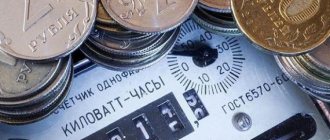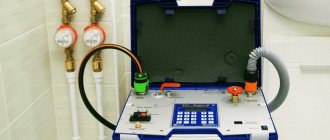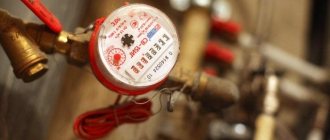A conventional electric meter measures the energy consumed. Its operation does not require intervention for maintenance, but after several years of operation it must undergo a verification procedure.
The timing of verification of an electricity meter depends on the energy metering technologies used:
- electromechanical - the usual disk ones;
- electronic, including imported ones.
Purely electromechanical devices for calculating consumed kilowatt-hours are tested at least once every 4–8 years of operation. Electronic devices can be assessed for accuracy every sixteen years.
There are several types of meters that are not subject to verification, that is, it is no longer possible to determine the accuracy of their operation and use it in practice. These models include metering devices with an accuracy class below 2.5. If such devices were used to calculate the energy used, then they must be dismantled and cannot undergo the installation procedure. After replacing them, you can change the energy metering circuit and install new input devices, including network connection wires from the general house wiring.
Dear readers!
Our articles talk about typical ways to resolve legal issues, but each case is unique. If you want to find out how to solve your specific problem, please contact the online consultant form on the right →
It's fast and free!
Or call us by phone (24/7):
If you want to find out how to solve your particular problem, call us by phone. It's fast and free!
+7 Moscow,
Moscow region
+7 Saint Petersburg,
Leningrad region
+7 Regions
(free call for all regions of Russia)
Old meters with a low level of class not only display with a high error, but are also unsafe to use. The special GOST, which was in force previously and made it possible to use instruments with an accuracy of 2.5, is now outdated. It does not apply on the territory of the Russian Federation.
Let's take a closer look at the cases in which it is necessary to plan an examination of the meter. We will also give advice on how to determine the duration of the verification interval. A few words will also be about the nuances of using newly purchased electricity meters for domestic use.
What is verification of electric meters
Users who encounter this procedure for the first time believe that it is a money grab. This is exactly what it may seem to a non-specialist, since outwardly a certified meter does not differ from a constantly working one.
However, in fact, verification is not a modernization or repair of a product. During its implementation, the properties and characteristics of the device are studied, its indicators can be adjusted to the values established by standards and GOSTs. For this purpose, special stands are used, where the devices undergo several stages of testing and measurements:
- the level (threshold) of sensitivity is established experimentally at minimum loads that are permissible according to the passport data;
- the possibility of the counter running independently is established, that is, the occurrence of a pulse without supplying current to the inputs;
- testing for operation with a symmetrical load (at various percentages of the rated current).
In addition, studies include an external assessment of the serviceability and integrity of parts and mechanisms. For electronic meters – electronic boards and parts.
An important part of the work on the testing stand is measuring the breakdown strength of the insulation by applying critically high voltage and current.
According to general rules, the verification period for electric meters depends on the materials used in them and the technical solutions implemented. The less mechanics and rotational elements are used, the longer the verification interval. There is more trust in the electronic system, since it is structurally difficult for external intervention.
Theoretically, changing energy metering - increasing indicators in a negative direction, reducing sensitivity or suspending metering - is possible in mechanical meters. In most models of electronic devices, such interference can lead to complete destruction of integrity. As a result, this will lead to additional expenses for the subscriber, since it will be impossible to use it in the future. In addition to paying a significant fine, you will have to buy a new meter.
https://www.youtube.com/watch?v=4hwnUQY0PU0
Checking the meter at home without removing it
At the moment, you can order verification, which does not require dismantling.
In this case, the algorithm of actions is as follows:
- By the date when the verification interval expires, you must select an organization that provides on-site services. To avoid problems, it is better to immediately check the availability of permitting documents.
- Make a statement. It is important to indicate all the information about the meter, as well as information about its location and the owner of the property.
- At the appointed time, a specialist will come and, using special technical means and techniques, will evaluate the functionality of the device.
- The control measurement is recorded, the data is entered into the act, a seal and signature are affixed. If the error is acceptable, then the mechanism is suitable for further operation, otherwise the meter must be replaced.
Do I need to check new electric meters?
There is no need to take the new device to specialists to analyze the serviceability and accuracy of the indicators, but regulatory documents still limit the time for the sale of new devices after they leave the factory.
If the metering device is stored under the conditions specified by the manufacturer in the technical passport, then it will not require an assessment of the quality of calculations of kilowatt-hours used. If the conditions did not meet the specified ones, then the frequency of verification is two calendar years. For three-phase devices, the verification interval is reduced to 1 year.
Why were such restrictions introduced? The fact is that storage conditions can vary significantly. Low temperatures, high humidity, and the presence of strong magnetic fields negatively affect accuracy and sensitivity. Moreover, predicting exactly how the meter will react is problematic: it may or may not “count” the energy actually consumed.
Legislative regulations
The need to verify electricity meters is established by Federal Law N 102-FZ “On Ensuring the Uniformity of Measurements”, in particular Article 13.
It determines the obligation to undergo verification, establishes the procedure for conducting verification, the persons or organizations that have the right to carry it out , and determines the means certifying the completion of verification (seals, signs, marks in the passport).
Who to call if the lights in the apartment are turned off without warning? Read about it here.
Types of verifications
Different models of electric meters have their own verification period. It depends mainly on the time of commissioning, the technologies used and compliance with the technical requirements accepted at the time of assessment in the Russian Federation.
After installing it in the house, you will need to submit the meter for verification after 8-16 years of operation. In addition to the initial verification, there is an emergency verification (extraordinary) and periodic. Each of them is determined by the rules for the operation of electrical devices and devices, and is also enshrined in regulations.
Primary
The subscriber has no direct relation to this type of verification of the electric meter. It is carried out at the manufacturing plant. This assessment of quality characteristics is carried out as soon as the product is finally completed and ready for shipment to the consumer.
Factory initial verification, carried out at an industrial manufacturing enterprise, makes it possible to qualifiedly determine the quality of operation of a specific unit from a series of metering devices.
All indicators that must comply with standards and certification conditions are included in the technical documentation. It accompanies the product and is handed over to the buyer in technical supermarkets. Data on the class and other important characteristics of metering devices included in the technical documentation are not subject to additional verification.
The law gives the right of primary technical control to the enterprise regardless of the metrology and standardization bodies. They can determine the suitability of the device for operation. However, there are some time restrictions. This is a legal requirement.
If the storage time of a product after its manufacture is more than 1 year, initial verification is not enough - periodic verification is carried out. The owner of the device will have to pay for it. This norm is also specified in the rules for electrical installations - the ABC of power engineers - PEU.
Periodic
Periodic verification is carried out at different times and depends on the type of metering device used. The usual period for periodic peer review is 8 years. A longer period is set for electronic versions of devices.
The time after how many years a periodic assessment of the quality of a metering device is carried out is established depending on the specific circumstances or the time of commissioning:
- new metering device - from the time of production (from the moment of factory packaging);
- installed device - from the moment of operation and recording of this information and indicators in the accounting documentation;
- for the device used - from the time of the previous verification.
Extraordinary
Such verification of meters is carried out by the user himself or the controlling organization at any time when required. The reason for its implementation is the doubtfulness of the accuracy of measurements or obvious signs of distortion of the measured indicators.
In addition, this type of analysis of the quality of the meter’s operation is carried out if there are abnormal situations:
- documentation is lost and there is no way to clearly establish the date of the previous or initial verification;
- if the device has been repaired and it is necessary to check the quality of measurements;
- if a comprehensive replacement of equipment is being carried out and verification of metering indicators is required.
How to do it?
Verifying the meter is a more important procedure, the higher the electricity consumption for a given meter. Below is the algorithm (road map) of the event under consideration.
Where to go?
To initiate the verification procedure for their electric meter, the owner or responsible tenant of an electrical energy consumer facility
- or directly to the energy sales company with a statement about holding this event;
- or to any accredited organization that is qualified to verify the consumed electricity meter.
Methods
The verification step common to all methods is to inspect the device for the presence of mechanical damage. The compliance of the meter passport data available with the energy sales company with the realities and compliance of the labeling with existing state standards is also checked. Next, the verification procedure is performed according to one of the following scenarios.
Without removing the device
If there is no visible damage or signs of breaking, and the numbers on the device correspond to those indicated in the device passport, then we are limited to verification activities without removing the device itself from its installed place. The following actions are carried out:
- Insulation integrity assessment.
- The functionality of the counting mechanism is checked. (The meter is connected to the power supply for 15 minutes, supplying the rated voltage and operating current. The results must match the data indicated in the passport).
- Checking the absence of “self-propelled gun”. (The load is applied to a parallel electrical circuit and the readings of the meter are recorded, which should remain motionless).
- The sensitivity threshold is determined (confirmation of the accuracy parameter).
- The manufacturer's stated error in measuring the energy passed through the device is confirmed.
When all these steps are completed, the metering device is resealed, and a verification stamp is applied to the seal.
Information about the verification performed is entered into the passport of the measuring device (section “Information on verifications”). The imprints on the seal and in the product passport must be the same.
Calibration interval for electricity meters: mechanical, electrical
Details of what calibration intervals are for specific device models can be found in the technical documentation and GOSTs, which regulate current measurements in single-phase and three-phase networks.
Those who are encountering verification intervals for the first time should understand that they differ in the ways in which energy consumption is calculated:
- mechanics will require more attention and therefore the term here is no more than 8 years;
- There is no strict time limit for electronics - no more than 18 years.
For mechanical and electronic types of metering devices, the difference in the verification interval can be from 2 to 4 times. The more complex the device and the more components and parts it contains that may be subject to mechanical or electromagnetic influence, the shorter the calibration interval.
The calibration interval of electric meters strongly depends on the strength of the materials and their wear resistance. Not only mechanical strength is important, but also the strength of materials that are subject to constant electromagnetic influence and pass through significant electrical charges.
A violation of the indicators may appear after a short circuit or the passage of current with non-standard indicators that are inflated by thousands of times.
As a rule, domestic and foreign manufacturers use the standards adopted in the country to determine the verification interval. This data must be entered into the meter passport. They become the basis for determining the evaluation interval for the quality characteristics of the meter.
Both in Moscow and other large cities of Russia there are special certified centers for carrying out work to verify the accuracy of the operation of electrical metering devices. The choice of a specific organization depends only on the consumer. No one has the right to force a consumer to go to a specific company. He himself chooses a certified center based on the speed of work completion and an attractive price position.
https://www.youtube.com/watch?v=hbwUMmBuQtU
Single-phase meters
The verification period for electric meters used in a regular household network is no more than 16 years.
Maximum MPA (calibration interval) for new electronic models. They are factory tested and supplied with documentation confirming such tests.
But there is an important point that a new resident or someone who is renovating an apartment or house needs to remember. After purchasing a single-phase metering device, the inspection period should not be more than 2 years. If a single-phase electricity meter is installed beyond the initial verification period, this meter will not be considered a legal meter by power engineers. And this may have material costs.
If there is a delay, you will have to re-check even a new (in perfect condition) metering device.
Three-phase meters
The calibration interval for a three-phase electric meter ranges from 5-8 to 16 years.
Basically, such electricity metering options are used for large premises or houses with powerful household devices - electric heating of “warm floors”, “warm walls”, air conditioning and ventilation systems of a “smart home”, lifting water from a significant depth.
If a three-phase electricity consumption meter is purchased after 1 year of being on the supermarket shelf, it will need to be verified again.
Types and classifications of devices
Electronic electricity meters
Based on device type, meters are divided into the following categories:
- Mechanical. They operate on the principle of electromagnetic induction. When current passes through the coils, a magnetic field is created that rotates the disk connected to the dial. The greater the load, the faster the rotation and the larger the reading. Since rotation is accompanied by friction, induction devices are installed in facilities with a small number of consumers.
- Electronic. Energy consumption is taken into account by a chip that is highly sensitive and picks up even weak impulses. The read data is fed to the actuator, which displays it on the front panel. Today, mechanical devices are being replaced with electronic ones.
- Electrodynamic. They combine mechanical and computer components. They have high power, durability and reliability. Designed for heavy loads, therefore they have a narrow range of applications.
Single-phase induction meter
According to measuring values:
- Single-phase. Designed for current voltage 220 V and frequency 50 Hz. Installed in residential and commercial premises connected to the household network.
- Three-phase. Designed to operate with a voltage of 380 V and a frequency of 50 Hz. They are used for industrial equipment and electric stoves, which are installed in some apartments.
By connection type:
- Directly into the household chain. In this way, metering devices are connected to common panels located in apartments and private houses.
- Through transformers. Used when connecting to a high-voltage line and for products operating at 380 V.
The verification period for electric meters is determined separately for each device after comparing the manual and operating conditions.
Where to go to check your electricity meter?
Enterprises that specialize in providing standardization and metrology services check the performance and quality of meter measurements using on-site and laboratory tests.
It is advisable to pre-coordinate the replacement of the device with the energy supply company. This will allow you to avoid troubles in the form of penalties for unauthorized dismantling and installation of the meter.
After the application is accepted, power engineers are required to approve this installation, having previously studied:
- accuracy class;
- dimensions of the device (dimensions) for installation in a panel room;
- compliance with Russian standards and norms.
Interval of electricity meters from 5u, so i62, stsatt 31a and others: device life, table
To take into account the electrical energy consumption of each apartment or house, electricity meters are installed. Whether their work is correct or not is determined during testing. What checks exist, what is included in each of them, what does the table of the verification interval of electric meters look like? More on this later.
What it is
Verification of electricity meters - examination of equipment using special measuring instruments, as well as comparison of the resulting indicators with those recognized as reference standards by an accredited organization.
Verification differs from verification in that in the first case it is supposed to carefully study the meter, its mechanism of operation, performance and technical characteristics laid down by the manufacturer.
Checking is an external examination with pliers and a multimeter.
Electricity meter as a common equipment
According to the federal law on uniformity of measurements No. 102 and standard No. 261 on energy saving, certified electric meters can operate.
Verification is a mandatory procedure confirming the fact that the measuring device is in working order in order to carry out accounting tasks. This is an analysis of electric meter readings with a standard, which may have some errors.
Based on the measurements obtained, the magnitude of the error is determined.
Note! The verification consists of inspecting the electric meter for damage, diagnosing electrical insulation, determining operating faults, checking the self-propelled device and diagnosing the sensitive threshold.
Definition of checking electric meters
Kinds
Checking the electric meter can be planned or forced. It is performed by using a tester, current clamps or incandescent light bulbs. Needed to establish the theft of electrical energy or the incorrect operation of the device. The readings are taken by the owner himself or a competent representative of the service organization.
Types of checks
Varieties of MPI
The inter-verification interval is the permissible period of operation of the electric meter between two verifications using an energy meter. It is prescribed in the technical passport and is up to 16 years for different electric meters.
Single-phase meters
The calibration interval for a single-phase induction meter is 16 years, for an electronic meter it is 5-16 years, depending on its rated current. An exception is a device with a rated electric current of 10 amperes.
Three-phase meters
The calibration interval for a three-phase induction meter is 4-8 years, and for an electronic one - 4 years, which has a rated current of 5 amperes.
Note! Other electronic devices are checked every 8 years.
Check frequency table for three-phase devices
Where to go to check the device
To call an employee, you need to go to the metrology laboratory department, which is accredited. The location can be found in an organization that monitors electricity consumption.
The person who owns it must bring the electric meter in order to carry out the test. Energy sales will notify you about how long it will take.
If a person is not sure that the device shows accurately, he can check his equipment himself and not wait until scheduled diagnostics occur. In this case, the owner of the electrical equipment can select the service himself.
Contacting the local metrological organization as necessary for equipment verification
How does the verification take place?
The equipment is checked by a metrology company that has valid accreditation. First, the user receives a notification that diagnostics are needed. Then the employee checks the equipment and draws up a report that the procedure was carried out. The document is provided to energy sales.
There they look at it and use it to draw up permission for the device to continue to be used. If it does not meet the requirements, it is replaced with a new one. An electricity meter that has an accuracy class of 2.5 is not verified.
The user can select the organization that evaluates the metering device.
Note! Performance is determined by five actions. First, the correct connection is determined, the self-propelled vehicle is calculated, the gear ratio is looked at, then the error is calculated and the magnetization is revealed.
Equipment testing technique
What marks are made?
After the tests, a certificate is issued that the device has been tested and can be used in operation or is unsuitable. The information consists of the date and degree of error found during the test. The meter is marked with the verifier's mark. This stamp is an anti-magnetic sticker or seal with a stamp imprint.
You might be interested in this Three-zone meter Marks in the technical documentation upon completion of verification
Is it possible not to remove the counter?
There is a similar way to check the accuracy of equipment. To do this, you need to draw up an agreement and pay for the work of an employee of a metrological institution. He comes to your home and performs diagnostics using the appropriate methodology. Diagnostics at home is advisable to save time. Well, you have to wait a few weeks.
Methodology for checking electricity meters
Once it has been established, based on technical documentation or due to an urgent need, that the time for verification of the electric meter has arrived, it is sent to the standardization and metrology laboratory. There is another option. If the stipulated verification interval expires, specialists will work on site. That is, the subscriber orders the service of visiting experts at home.
In both cases, the expert, after taking measurements, issues a verification certificate. It describes the necessary technical characteristics of the device, established experimentally.
While working with a stationary laboratory stand or remote device, specialists conduct a thorough analysis of the actions of the metering device in various modes:
- how high current and high voltage affect accuracy and serviceability;
- is there any unauthorized movement of the meter to count unused electricity;
- whether the insulation, mechanics and electronics of the device can withstand increased load.
If all parameters are within the specified parameters, testing ends. The sealing is carried out along with the installation or re-sealing is carried out if the work is done at home.
Any type of meter must have two seals - the company that operates the device (energy industry) and the company that carried out the verification (standardization center). Only the presence of these two seals guarantees its safe and legal operation and further absence of claims from power engineers.
How and what marks are made
After the meters go through the full procedure of analyzing the accuracy of accounting for electricity consumption data, marks are affixed. They are entered in writing manually with a stamp and indicating the number of the verification certificate.
The inspection organization makes a mark in the accounting documents and simultaneously enters data into the internal documentation of the company. This is necessary for control and, if necessary, this data can become the basis for issuing duplicate documentation.
Based on the results of the experts’ work, the subscriber is given a separate document - a certificate (certificate) of verification of the metering device. It indicates all the main indicators and confirms the possibility of using the device. The technical statement of suitability for energy consumption measurements confirms its continued safe use.
Is it possible not to remove the electric meter?
Yes, you can order the service to your home. This is one of the options for quickly meeting the requirements for the calibration interval. In Russia, any licensed organization can provide such a service, but it is best to contact government agencies in the field of metrology and standardization. There are many private companies with positive practices in this direction.
By law, the energy supply company is no longer the only one providing this type of service.
In order not to remove the meter and carry out verification legally, you should notify power engineers about it and conclude a service agreement with the performers.
There is no difference between verification in a laboratory or on-site. Neither in legal legality nor in technical accuracy does this assessment of the serviceability of the meter differ. The only difference is the price. For field work, metrologists can charge a significantly higher amount. This is because field work involves paying a specialist to work using transport and portable measuring equipment.
Service cost
Payment for verification services can have a significant range in prices. The maximum amount is paid for an urgent service, that is, when the master arrives, checks and seals everything in 1 calendar day. In this case, the minimum rate increases by 200-250%.
If verification is carried out within 3 working days, the price increases by no more than 40-50%.
The minimum rate for the service of assessing the performance of the meter is 700-800 rubles.
The maximum fee for expert conclusion on complex three-phase devices does not exceed 3.5 - 4 thousand rubles.
The on-site and stationary types of verification to fulfill the conditions of the MPI may practically not differ from each other. The whole point is that it is necessary to calculate all overhead costs: dismantling, installation of the device, its transportation, time for transfer, documentation.
Who pays
State verification is ordered at the expense of the subscriber’s personal funds. This obligation is clearly stated in the text of the Government resolution that regulates the retail electricity market. That is, the meter must not only be purchased, but also actually used by one person - an individual or legal entity. Only when the owner is clear does the obligation arise to carry out verification and protect the device from breaking seals or otherwise compromising the accuracy of accounting.
Some subscribers are in no hurry to delineate responsibility for metering devices. However, during the next inspection, accounting can be transferred to a standard assessment, and the meter will not be used to record consumption data. Therefore, registering meters and assigning ownership is ultimately more beneficial for the subscriber than trying to evade their service.
Electric meter verification procedure
The verification period for the electricity meter is controlled by the owner of the apartment or private house. The obligated citizen must independently agree on the date of transfer of the device for diagnostics and deliver the IPU to the address of the metrological center. However, at the legislative level, conducting verification without removal is an acceptable procedure if the contractor has accreditation.
Step No. 1: Analysis of the correct connection of the electric meter
The use of a control device depends on the type of IPU and the number of phases. On the diagram this can be reflected as two connected inputs - zero and phase, as well as the point of connection with the load circuit.
The controller can diagnose problems with the electric meter by identifying additional sources of connection to the network. In the second case, suspicion may be caused by a violation of the connection sequence.
Deviations from the norm are grounds for additional verification, since such cases often indicate theft of resources through unauthorized connection. The correctness of the connected individual energy consumption device is carried out by simple inspection.
Step #2: Self-propelled research
The concept of “self-propelled” meter means circumstances under which the device disk rotates without additional load, i.e., on its own and at the same time all electrical appliances are de-energized. After turning on all the diverter automation, the controller observes the movement of the mechanism for 7-10 minutes.
If the device is working properly, then rotation will not occur, and the indicator will not show more than one pulse. In the opposite situation and a flashing sensor, the procedure ends with re-verification or installation of a new IPU.
Step #3: Gear Ratio
The gear ratio is set on the external panel of the electric meter. The coefficient provides information to the consumer and the RSO about the number of revolutions or blinks - the type of reading depends on the type of device.
How to understand that it is time to replace the meter.
Based on the rotation of the disk or electronic indicator, the consumed resource is calculated. In other words, these figures act as indications for calculating electricity - 1 kilowatt is equal to the approved tariff in the region.
Step #4: Establishing the error
Another necessary stage of conducting an inter-interval check of the electric meter is error diagnosis. The event is conditioned by establishing the correctness of the transmitted readings.
Step #5. Detection of meter magnetization
A pressing question for consumers is how often the electric meter is checked for magnetization. The topic is of interest to those property owners who have an old-style disk device installed. The new generation of IPUs are created on the basis of induction and have a protective seal that changes color when interacting with a magnet. Verifications of this type are required by the RSO to be carried out no more than once every six months.
An analysis of the magnetization of an individual consumption device can be carried out using a regular needle - if it is attracted to the equipment, then, therefore, the IPU has a strong magnetic field. It is noteworthy that such circumstances work both to the consumer’s advantage and to the disadvantage. That is, prohibited devices will not slow down, but, on the contrary, will accelerate the rotation of the disk, which means the owner will pay more.
Verification period
The timing of verification of electricity meters depends on the specifics of the procedure, i.e. whether the IPU needs to be removed or not. In the first case, a thorough diagnosis and issuance of a result on the possibility of operation will be required. This procedure can take several hours or 2-3 days.
If the inter-verification analysis does not require dismantling the electric meter, then the defining parameters are:
- diagnostics of the nominal voltage in the network - takes about 15-20 minutes;
- checking the fact of “self-propelled” – this will take 10-20 minutes;
- 10 min. an inspection is performed to ensure that there are no physical defects on the IPU;
- additional time is spent completing the report on a special form and sealing the meter.
High verification error
The standard accuracy class accepted today for energy metering by ordinary subscribers is 2 and higher.
How to determine how much the meter overestimates the readings? What is the real error of the device? To do this, you need to familiarize yourself with the verification certificate. It clearly indicates all the performance indicators of the meter.
Sometimes an emergency situation arises when, after verification, doubts arise about the reliability of the data recorded by it. In this case, it is recommended to conduct a repeated (emergency or extraordinary) expert assessment of the quality of the device.
The number of verifications is not regulated by law and depends on the wishes of the subscriber. However, it should be remembered that only if an inaccuracy in the movement of the device or other shortcomings is detected, will it be possible to compensate for the amount spent on verification. In other cases, the organization for standardization and metrology will have the right to demand payment of a repeat invoice.
How to check if the electric meter is working correctly
For the sake of curiosity, you can check how accurately your meter measures electricity consumption with your own hands and at home. But such an experiment, of course, cannot be considered a verification.
So, to carry out such a test, you will need access to a meter, an incandescent light bulb as a load, a multimeter, a calculator and a stopwatch. The order of your actions will be as follows:
- Measure the voltage (U) in the network using a multimeter.
- With the multimeter in ammeter mode, measure the current (I, A) in the light bulb.
- Calculate the resistance of the light bulb R=U/I, Ohm.
- With the light bulb plugged in, measure how long it takes (T, hour) for the counter to blink (turn the dial) 10 times. At the same time, it is necessary to monitor the voltage in the network.
- On the front panel of the metering device its so-called constant is indicated (A, imp/kWh). Find this number.
- Calculate the actual power consumption P=UxU/R, W.
- The error of the electricity meter (D) is calculated based on preparatory calculations using the following formula: D= (PxTxA-1)x100%
Below is a video about checking your electric meter yourself when you have doubts about its readings:
Is it possible to repair an electric meter?
This is possible, but only in certified centers or directly from metrologists. Any attempt to expose the device to external influences will result in the opening of the case and penalties.
Unauthorized attempts to repair an emergency or broken meter will result in negative consequences - termination of power supply from the energy supply company. In addition, a faulty device is dangerous to operate and can cause a fire, short circuit, or spontaneous combustion due to overheating of the insulation.
Self-checking the serviceability of the electric meter before the end of the verification period
Independent actions of the subscriber are possible, but require approval. The first condition is to receive a warning about the need for verification. If such a warning is received, you must contact your energy supply company. She organizes the installation of seals and their removal with activation.
If the subscriber wishes not to remove the meter, but to use the service of specialists visiting the home, he must draw up an agreement and pay for this type of service.
Without the use of portable devices for testing the operation of the meter and computerized verification of the results obtained, it is impossible to make an objective assessment of the operation of the meter.
Why check the meter?
Verification of electricity meters is necessary for:
- Error corrections. If the electricity meter is still usable, but does not show accurately, the management company makes an adjustment. After this, it is put into operation again.
- Checking seals. Done to prevent fraud.
- Eliminate idle speed.
- Increasing the shelf life of the electric meter in the apartment.
If the verification period has expired, but the service life has not expired, only reuse of the energy meter is allowed.
What to do if the verification period has expired
If the subscriber is absolutely sure that the verification period has expired and the time has expired, you should still contact the service center.
If the time for verification has been exhausted, but the device continues to be used, the subscriber will be responsible for this, not the energy sector. The longer the period of operation without verification, the greater the fine may be. Energy companies can prove in court that the device is faulty or inaccurate and recover significant funds from the negligent subscriber.
Is there any liability for failure to carry out verification?
There are no penalties against the owner for failure to comply with the deadlines for checking electric meters.
When a device expires, its readings are considered invalid . You will have to pay for electricity according to a standard that significantly exceeds the actual use of electricity.
Energy sales employees draw up a report on unspecified electricity consumption, according to which recalculation will be made from the date of expiration of the verification period.
For the first four months, the amount for electricity consumption will be equal to the monthly average, or to the data of the general house electricity meter, and then according to established standards.
What nuances need to be taken into account
When buying a new meter, you should not forget that it can only be used with a certain accuracy class. For household, that is, standard connections of an apartment or house, accuracy classes are used:
- 0,5;
- 0.5S;
- 1;
- 2.
If a meter with a measurement accuracy of 2.5 or more is used, it will have to be replaced. Therefore, you will need to look for a new device in advance, preferably electronic.
What else are good about electronic models? The ability to integrate them into remote systems for receiving and transmitting information. You can forget about the routine work of calculating kilowatts, recording data and making phone calls to the energy company forever.
If a meter is installed for a three-phase network, you will have to keep double metering of energy: reactive and active. These are higher costs, although there are greater opportunities for using electrics for domestic and commercial needs.
Where to go?
Where to check the electric meter?
Information about local metrological departments that verify electricity meters can be obtained from your management company or energy sales authorities.
For verification, it is not necessary to turn off the meter and transport it to the laboratory; often it is enough to call an inspector to your home.
There are methods that allow you to test metering devices on site; often this option is even preferable , since it can reveal incorrect connection or improper operation of the meter.
You can find out what benefits for utility bills a group 2 disabled person is entitled to in our article.











